ISSN ONLINE(2278-8875) PRINT (2320-3765)
ISSN ONLINE(2278-8875) PRINT (2320-3765)
Vinoth A1 Raja T2
|
| Related article at Pubmed, Scholar Google |
Visit for more related articles at International Journal of Advanced Research in Electrical, Electronics and Instrumentation Engineering
A wireless sensor network is proposed for monitoring buildings to assess earthquake damage. In existing method for controlling all the process manual operation is needed. To overcome this change the full control systems into automated manner. The sensor nodes use micro-electro mechanical systems (MEMS) and vibration sensors. Both the sensors are fixed at the building to measure the seismic response of the building during earthquake. The entire process requires large energy, to avoid this energy consumption several countries recently made laws related to standby power consumption. To success this exertion we should consider not only the power reduction but also efficient automatic control in networked home environment. Here propose Host-Agent based structure to control standby power of consumer electronics effectively. Host and Agent are the two main components. Host manages the entire system and generates standby power control command. While the Agent steer actuator according to control command received from the Host. It is also proposed to prevent the human’s life from earthquake disasters. When the earthquake may occur here we use two motors. One for opening all the windows and doors automatically and another motor will also cuts all AC electrical lines. Effective way of monitoring is done through highly sensible sensors.
Keywords |
| MEMS, Vibration Sensor, Embedded Architecture. |
INTRODUCTION |
| Buildings can progressively damage during their operational lifetime, due to seismic events, unforeseen foundation settlement, material aging, design error, etc. Periodic monitoring of the structure for such damage is therefore a key step in rationally planning the maintenance needed to guarantee an adequate level of safety and serviceability. However in order for the installation of a permanently installed sensing system in buildings to be economically viable. In project the major part of work is doing in controller getting sensing information from various sensors, and then that value sent to controller that controller control the output parameters with the help of relay driver circuit, if MEMS & vibration sensor sensed give the buzzer sound, and then turn on the door motor, and turn off the ac main supply |
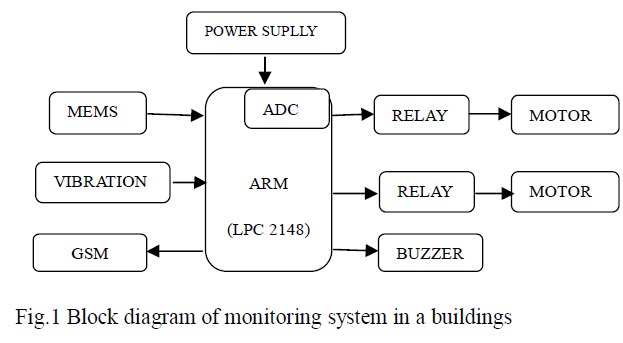 |
| In this sensor modules must be wireless to reduce installation costs, must operate with a low power consumption to reduce servicing costs of replacing batteries, and use low cost sensors that can be mass produced such as MEMS sensors. The capability of MEMS and wireless networking for monitoring civil structures is well documented. The presented work addresses all of the above requirements. The key characteristic, however, is being dedicated to handle a particular task. Since the embedded system is dedicated to specific tasks, design engineers can optimize it to reduce the size and cost of the product and increase the reliability and performance. Some embedded systems are mass-produced, benefiting from economics of scale. Physically, embedded systems range from portable devices such as digital watches and MP3 players, to large stationary installations like traffic lights, factory controllers, and largely complex systems like hybrid vehicles, MRI, and avionics. Complexity varies from low, with single microcontroller chips, to very high with multiple units, peripherals and networks mounted inside a large chassis or enclosure |
SYSTEM ARCHITECTURE |
A. Network Architecture |
| The monitoring system consists of two types of sensor modules: Micro-electro mechanical systems (MEMS) and vibration sensors. Both the sensors are fixed at the building to measure the seismic response of the building during earthquake as shown in Fig. 1. MEMS have the ability to sense, control and actuate on the micro scale, and generate effects on the macro scale activation of the building after an earthquake. Vibration sensors measures the vibration of the building) at each level during an earthquake, allowing analysis of the seismic response of the whole structure. The entire process requires large energy, to avoid this energy consumption several countries recently made laws related to standby power consumption. To success this exertion we should consider not only the power reduction but also efficient automatic control in networked home environment. Here propose Host-Agent based structure to control standby power of consumer electronics effectively. Host and Agent are the two main components. Host manages the entire system and generates standby power control command. While the Agent steer actuator according to control command received from the Host. It is also proposed to prevent the human’s life from earthquake disasters. When the earthquake may occur here we use two motors. One for opening all the windows and doors automatically and another motor will also cuts all AC electrical lines. Effective way of monitoring is done through highly sensible sensors. |
B. MEMS SENSOR |
| MEMS is a process technology used to create tiny integrated devices or systems that combine mechanical and electrical components. They are fabricated using integrated circuit (IC) batch processing techniques and can range in size from a few micrometers to millimeters. These devices (or systems) have the ability to sense, control and actuate on the micro scale, and generate effects on the macro scale. |
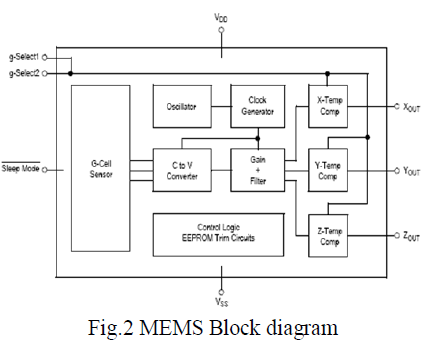 |
| MEMS or Micro Electro Mechanical Systems is a technique of combining Electrical and Mechanical components together on a chip, to produce a system of miniature dimensions. By miniature, we mean dimensions less than the thickness of human hair. |
 |
C. Sensor Module Architecture |
| The block diagram of the sensor modules is shown in Fig. 3 Both the vibration sensor and MEMS sensor of the module use the same core components. For installation into the building these components are placed into the building. The major part of work is doing in controller getting sensing information from various sensors and then that value sent to controller that controller control the output parameters with the help of relay driver circuit, if MEMS & vibration sensor sensed give the buzzer sound, and then turn on the door motor, and turn off the ac main supply. Same way to transmitted information to consumer sections with help of GSM modules which could pose a problem during seismic events. The receiver GSM can store and process the data or forward them, immediately or later, using classical wide area network connection technology. The data acquired during seismic events can be properly recorded even in case of outages of the electric power and/or communication networks the data acquired during seismic events can be properly recorded even in case of outages of the electric power and/or communication networks. To avoid rapid battery depletion, the modules with router functionality are mains powered through an AC/DC adapter, with the battery serving only for back-up power in case mains power is interrupted. The end nodes (i.e. the large majority of installed sensor modules) are powered exclusively by their battery. In order to save energy, several countries recently made laws related to standby power consumption. To success this exertion, we should consider not only power reduction of consumer electronics itself but also efficient automatic control in networked home environment. |
PROPOSED SYSTEM |
| In this project we have MEMS accelerometer to sense the shaking of the building which in sends to the microcontroller which in turn sends to the monitoring section through GEM wireless technology |
Transmitting Section: |
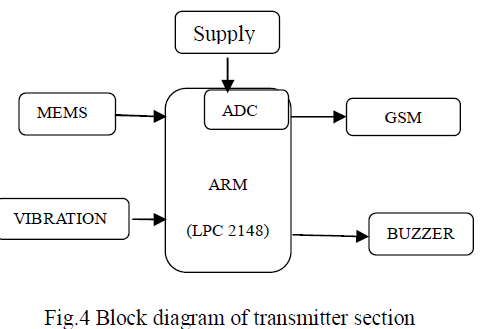 |
| Here we have three sections; the floor section has microcontroller, GSM device, MEMS and vibration sensors. The monitoring section has sensors and a GSM wireless device, which will collect the data from the building and analyze the stability of the building. |
Receiving Section: |
| CONSUMER SECTIONS |
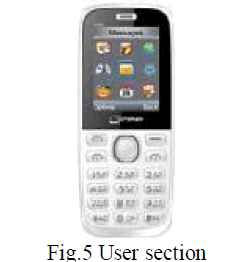 |
A. ARM LPC 2148: |
| ARM designs microprocessor technology that lies at the heart of advanced digital products, from mobile phones and digital cameras to games consoles and automotive systems, and is leading intellectual property provider of highperformance, low-cost, power-efficient RISC processors, peripherals, and system-on-chip (SOC) designs through involvement with organizations such as the Virtual Socket Interface Alliance (VSIA) and Virtual Component Exchange (VCX). ARM also offers design and software consulting services. ARM's architecture is compatible with all four major platform operating systems: Symbian OS, Palm OS, Windows CE, and Linux. As for software, ARM also works closely with its partners to provide optimized solutions for existing market segments. |
B. GSM |
| GSM stands for Global System for Mobile Communication and is an open, digital cellular technology used for transmitting mobile voice and data services. The GSM emerged from the idea of cell-based mobile radio systems at Bell Laboratories in the early 1970s. The GSM is the name of a standardization group established in 1982 to create a Common European mobile telephone standard. The GSM standard is the most widely accepted standard and is implemented globally. The GSM is a circuit-switched system that divides each 200 kHz channel into eight 25 kHz timeslots. GSM operates in the 900MHz and 1.8GHz bands in Europe and the 1.9GHz and 850MHz bands in the US. |
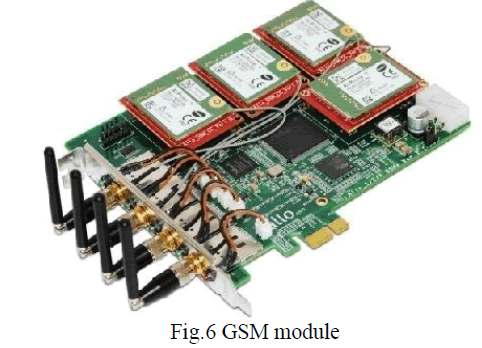 |
| The GSM specifications define the functions and interface requirements in detail but do not address the hardware. The reason for this is to limit the designers as little as possible but still to make it possible for the operators to buy equipment from different suppliers. The GSM network is divided into three major systems: the switching system (SS), the base station system (BSS), and the operation and support system (OSS). The GSM provides basic to advanced voice and data services including Roaming service. Roaming is the ability to use your GSM phone number in another GSM network. A GEM digitizes and compresses data, then sends it down through a channel with two other streams of user data, each in its own time slot. It operates at either the 900 MHz or 1,800 MHz frequency band. |
RESULTS |
| For estimating building condition using GSM given below. Using Proteus Design Suite, the simulation results of SMS based physiological parameters Monitoring System is given below Fig 7 and Fig 8: |
| After getting result in Proteus Design Suite, the execution process is going to done. While executing, we will get the normal values for building condition. |
Building Condition Abnormal |
| If the building condition is abnormal, the “UR BUILDINGS HAS COLLAPSED” i.e., it sends Building abnormal to send the message in phone number or (users) using GSM. |
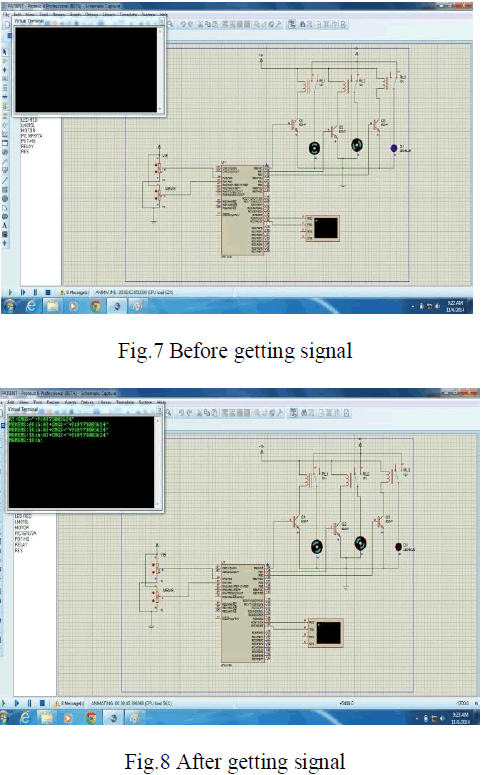 |
CONCLUSION |
| Wireless system for building monitoring takes advantage of the unique features of custom-developed MEMS sensors and vibration sensor combined with an optimized network and module architecture, to realize a solution which offers long battery lifetime and potentially low cost in manufacturing, installation and maintenance, while providing high quality sensor data at the right time. In previous method Manual operation is needed for checking Buildings, the Information Getting after the Incident, Controlling system at that specified location only, Detecting system moves only certain direction only. These are the drawbacks in the previous paper; overcome all these problems in proposed work with providing high accuracy for detection of Earth Quake, Monitoring from remote places, less cost, efficient communication facilities. It gives better performance compared with the previous. In this project human’s life will be saved by getting information before the incident through GSM. |
References |
|